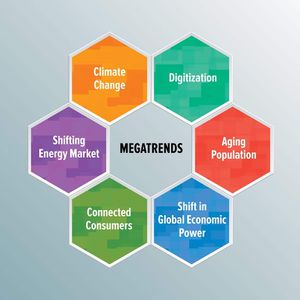Megatrend Analysis
How Megatrends Drive Innovation[1]
Global megatrends represent changes in our world that have a sustained impact on everyone. There are many online references and reports that discuss their importance. Understanding how these megatrends impact your business can provide insight and inspiration into your future product portfolio. While one can argue which megatrend(s) will be the most influential, there is no doubt they paint an interconnected narrative that will have implications for product development. Drilling down into each megatrend can reveal opportunities for innovation.
- Digitalization has brought us the internet-of-things, artificial intelligence, augmented reality, 3D printing, and sophisticated robots. These tools can strengthen brands by creating product visualization applications, enterprise manufacturing and quality systems, robotic painters, and new types of polymers to literally print a structure in-situ. How are you leveraging these new tools?
- The aging population has resulted in an increased focus on everyone staying healthy longer. Consumers are more concerned about the toxicity of things in their home, and this may influence their buying decisions. How are you addressing their concerns with your future product offerings?
- The shift in global economic power has created wealth in previously poorer regions and changed supply chain logistics. Populations with increasing wealth are better able to buy products. Are you taking advantage of this increasing opportunity?
- Connected customers means on-demand access to information and products at the touch of a button. It has created the ability to instantly comparison shop and make decisions on what to purchase and how to pay for it. Witness the decline of many great retail brands like Sears and the growth of online brands like Amazon. The power of the connected consumer is real. How is your business working with the global online customer?
- The lower demand for oil and the increasing demand for alternative sources of energy from wind, solar, battery technology, and geothermal will continue. We already see a shift to more efficient means of transportation in battery-powered vehicles, self-driving cars, trucks and trolleys, and phone apps like Uber and Lyft, that provide us with convenient transport. Wind farms and solar panels will continue to be part of our landscape. How will the shift in these markets affect the way you deliver product?
- As climate change continues, natural disasters and abnormal weather patterns have resulted in water scarcity, flooding, forest fires, resource and food scarcity, and infrastructure damage. This creates the need for restoration products; better water-, mildew-, and UV-resistant technologies; and products that can be used in adverse conditions. Are you developing new products that address these issues?
Understanding how these megatrends impact your business and product development can provide a window into the future. Look at these trends as influencers in favor of disruptive innovation and new product opportunities, and your products will address the needs of future generations.
Tips for Using the Megatrends[2]
- Avoid “all or nothing” thinking. Megatrends tend to make people think about inevitable and all-encompassing changes. In reality, the developments are rarely black and white. Urbanisation does not mean that everyone will live in cities, or that cities will remain unchanged. Automation does not mean that robots will take over all jobs, or that new jobs will not be created. It is advisable to challenge trends with countertrends and examine the tensions between them. This helps us see the shades of grey within them.
- Challenge assumptions and be open to different opinions. We often have preconceived notions about future directions of development. These notions tend to reflect our interpretations of the consequences of the megatrends. Nevertheless, we should challenge our preconceived notions and consider alternative interpretations. What factors do we expect to remain unchanged? When the population grows older, will life in old age remain the same as it is now? Does a rise in the standard of living inevitably lead to higher consumption? One good way to challenge one’s own assumptions is to discuss the megatrends with others and be open to different views.
- Complement the megatrends with weak signals. The megatrends paint a picture of changes that are happening now. However, in the post-normal age, we should also focus on discontinuities and surprises. Weak signals of emerging phenomena or the early symptoms of change help us consider less expected directions of future development.
- Examine the trends at the individual level. Megatrends help guide our thinking about changes at the global level. This may make it feel impossible to respond to them. How can we ever achieve the necessary major changes in society and our lives as quickly as they are needed? When we are faced with this kind of anxiety about the future, we should keep in mind that major changes have been achieved in the past, and changes are happening all the time. We just do not always notice the changes when they occur gradually. For added perspective, we should think about how the megatrends and the changes they necessitate are manifested in our daily lives.
- Don’t forget hope. In light of the megatrends, the future may appear threatening. Climate change, the ageing of the population and geopolitical power struggles may feel like insurmountable challenges and the future may appear lost. There are various threats out there. At the present time, it is important that we outline desirable futures. The tensions and uncertainties around the megatrends illustrate factors that we can influence.
- ↑ How Megatrends Drive Innovation Victoria Scarborough
- ↑ Five Tips for Using the Megatrends Sitra

